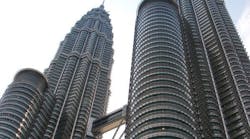A.D. Koen
Senior Editor-News
Latvia has begun expanding facilities at the Baltic Sea port of Ventspils in an effort to sustain the port's role as a main export terminal for Russian oil.
The project is part of a bigger plan by the Latvian government to add enough capacity to enable Ventspils to ship more than 80 million tons/year of all types of cargo by 2010.
Most of the oil related work at the port involves dredging to enlarge Ventspils' ship channel, turning basin, and oil piers to allow larger tankers to dock.
Increasing Ventspils' oil tankering capacity to match that of existing loading, offloading, and storage facilities onshore will eliminate a bottleneck that limits the port's oil export capacity to about 500,000 b/d.
By enabling Ventspils to receive and load larger tankers, officials aim to boost the port's oil export capacity to 800,000 b/d.
International Management Services (IMS), Friendswood, Tex., estimates Ventspils in 1995 exported an average 400,000 b/d of Russian crude oil. That represents about 33% of Russia's waterborne oil exports last year and 19.5% of the country's total crude exports when Druzhba pipeline throughput of 840,000 b/d into eastern Europe is included.
IMS is serving the Latvian government as an energy and economics adviser.
Latvia, since installation in 1967 of a 28 in. crude oil pipeline and 191/2 in. products line between Polotsk, Belarus, and Ventspils, has been a key pathway for Russian oil exports to the West. Since gaining independence in August 1991, the country has earned transit fees from Russia for relaying oil through Ventspils to western markets.
While Russian oil production has plummeted in the 1990s, falling to less than 6 million b/d from more than 11 million b/d, it has maintained exports at slightly less than 2 million b/d to earn as much hard currency as possible.
Ventspils overview
Latvian officials believe Ventspils soon could play a larger oil export role as Russia begins restoring oil productive capacity and increasing volumes are sold into western markets.
IMS reports Latvia has successfully sought financing to fund the larger Ventspils expansion plan.
"So far, these plans seem to be on target and, given continuing economic stability and no major external upsets, should be realized in full," an IMS study said.
A major outlet in the Baltic region for exports of potash, steel coils, food, grain, and timber, Ventspils at yearend 1995 hosted these main petroleum related tenants:
- Ventspils Nafta (VN) operates the largest automated oil terminal on the Baltic Sea. VN's facilities occupy a 65 acre site and include 69 storage tanks with capacities ranging from 30,000-125,000 bbl, as well as railcar and truck discharge and loading racks connected by pipeline to Ventspils' oil piers.
- Ventbunkers (VB) loads oil and distillates aboard about 1,700 ships/ year at Ventspils by way of three double sided oil piers and a shore side oil pier. All oil piers will be able to receive larger vessels following expansion of the port's ship channel and turning basins. Two oil berths are to be added. VB also operates 40 storage tanks with combined capacity of 545,000 bbl, along with 35 railcar cargo transfer points and two truck cargo racks, each with 10 vehicle positions.
- Ventamonjaks operates a chemical products terminal that handles about 1.8 million tons/year of products, mainly ammonia, methanol, ethanol, 2-ethylhexanol, normal bu- tanol, isobutanol, acetone, and a carbamide-ammonia mixture.
IMS says plans to expand Ventspils' oil capacity hinge on this dredging activity:
- Deepen to 56 ft at mean low tide (MLT) the ship channel and breakwater harbor and VB's three double sided oil piers.
- Deepen to 461/2 ft MLT the inner ship channel up the Venta River past Piers 9 and 15.
- Deepen to 461/2 ft MLT and widen to more than 1,083 ft the turning basin surrounded by Piers 6, 7, 16B, and 16A.
- Deepen to 41 ft MLT the inner ship channel past Piers 10 and 13.
Officials also plan to expand VB's oil Pier 1 on the Venta River channel to handle as much as 600,000 b/d of crude.
Other oil related construction planned at Ventspils includes tankage and manifolds at VB's terminal to handle another 80,000 b/d of products, plus piping and controls for receiving or shipping another 100,000 b/d of products.
Officials also plan to build a 120,000 b/d liquefied petroleum gas and condensate terminal for the company Vent- kondensats Inc.
Outlook
IMS said the most optimistic forecasts of the pace at which Russia will restore oil output allow for production to reach about 7.2 million b/d by 2000.
Even that outlook, IMS said, includes "a highly speculative component" of capacity achieved by repairing or replacing large segments of Russia's oil pipeline network. For example, the 28 in. Polotsk-Ventspils oil pipeline is in serious need of repair.
Expansion plans by other main ports exporting Russian crude, all on the Black Sea, reflect the belief that waterborne export volumes will increase.
IMS estimated that in 1995:
- Novorossiysk, Krasnodar, handled about 550,000 b/d of Russia crude on installed capacity of 650,000 b/d.
- Odessa, the Crimea, about 170,000 b/d on 190,000 b/d of capacity.
- Tuapse, Adyegi, about 90,000 b/d on 100,000 b/d of capacity.
Novorossiysk is to add 300,000 b/d of capacity and Odessa 600,000 b/d within the next 2-3 years, IMS said.
In addition, an international group of large companies, including Amoco, Exxon, Texaco, Neste, Lukoil, and Transneft, for the past 2 years reportedly has been planning to develop a series of fields south of the island of Novaya Zemlya in the Timan-Pechora basin.
That program would include laying a 1,400 mile pipeline to ship about 800,000 b/d of oil from the Timan-Pechora region to Primorsk, Russia, on the Gulf of Finland. At Primorsk, the group would have to construct all the oil handling facilities needed to convert a former Soviet naval base into one of Russia's largest oil terminals.
Pursuing the Primorsk option would allow Russia to maintain control over future Timan-Pechora crude supplies for all transportation functions through export, an often stated objective.
Yet an economic and technical evaluation by Ventspils' port board found that at least half the Timan-Pechora crude could reach world markets faster and cheaper through the Latvian port. The board said that's because:
- Ventspils has in place the required portside facilities, including storage tanks, pipelines, and pier capacities, to ship another 400,000 b/d of crude oil.
- Ventspils is exporting Russian oil to the same markets that would be served by an oil terminal at Primorsk.
- The cost of laying a pipeline to connect Ventspils with the Druzhba pipeline, an alternate route being considered for future Timan-Pechora supplies, would be less than the cost of connecting the proposed 1,400 mile crude line to the Druzhba system. In addition, much of the latter connection would traverse soil of unknown load bearing characteristics.
- Existing capacity at Ventspils lessens considerably the requirements for oil handling facilities that would have to be built at Primorsk.
A project to construct the pipeline and terminal facilities needed to begin exporting 800,000 b/d of oil from Primorsk would take several years to complete because of its sheer size, IMS said.
It also said, "If time is of the essence, as has been repeatedly suggested, then to neglect an existing, proven facility for an as-yet-unbuilt facility seems somewhat strange."
The evolution of Russian oil production and transportation patterns could change beyond current expectations the country's future export needs. While Latvia intends to capitalize fully on its strategic location between Russia's oil supplies and western markets, too much reliance at Ventspils on handling Russian oil could hold some strategic risks.
Thus, Ventspils is studying ways to adapt the port for two-way oil and refined product movements, as well as greater cargo diversity.
In addition, IMS said, businesses from Germany, Scandinavia, and elsewhere in Europe are finding entry to many Russian markets through Latvia.
If, as it appears, Ventspils' expansion plans are likely to be achieved within the intended timeframe, the port would be positioned to play a decisive role in the future of Russia and Latvia, IMS said.
Copyright 1996 Oil & Gas Journal. All Rights Reserved.

